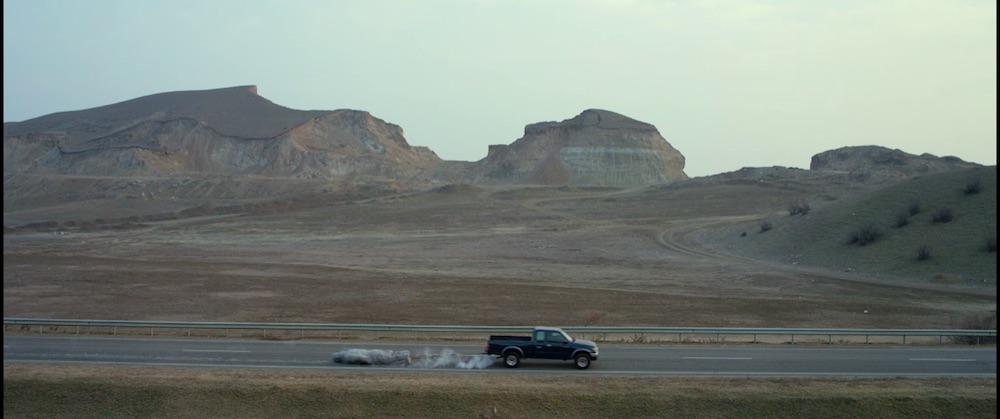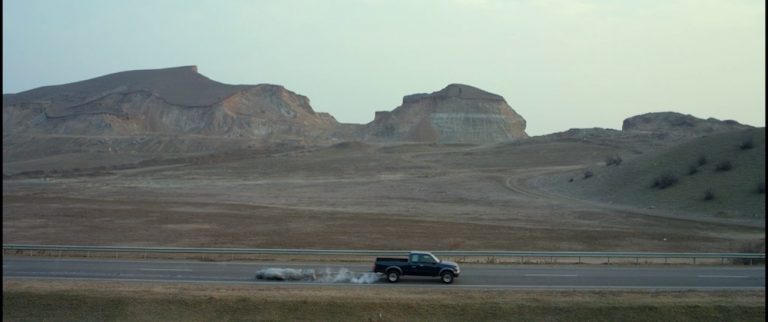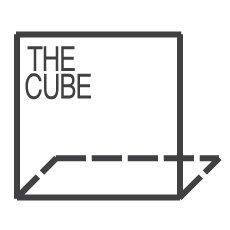
Vajiko Chachkhiani
Winter Which Was Not There, 2017, HD video, 12:30 min.
Courtesy the artist, Daniel Marzona, Berlin and SCAI The Bathhouse, Tokyo
TheCube 7F

In Vajiko Chachkhiani’s video Winter Which Was Not There, a man watches a monumental concrete sculpture
being hoisted out of the sea. The sculpture is reminiscent of a classic depiction of a hero, but in a strange and
somewhat uncanny way, it looks stunningly like the man who is watching it rise out of the sea. After a long
drive through a series of landscapes during which the sculpture is dragged behind his vehicle, the protagonist
ends his journey with the monument fragmented and destroyed.
Chachkhiani weaves a discourse of liberation into a multilayered visual narrative that allows viewers to relate
to the video, regardless of their origins. The artist employs a classical sculpture as a metaphorical weapon to
decipher the intangible notion of human conscience. The video presents viewers with the critical dilemma of
having to define what is private or public, and reflect on the interrelations between the public sphere and our
sense of ethics. The artist’s prophetic vision seems to echo the current situation of decolonization that has led
to the removal of many historical colonial monuments, increasingly since the 2020 resurgence of the Black
Lives Matter movement.
We are often stranded with remnants of historical experiences projected onto our present reality. Building a
scaffolding of countless salient questions, this work offers a compassionate, intellectual confrontation with
the past as a way to consciously shape the present and future.
2017, HD video, 12:30 min.
-Curator|Balimunsi Phili
Vajiko Chachkhiani
(b. 1985, Tbilisi, Georgia) Lives and works in Berlin, he studied Mathematics and Informatics at the Technical University, Tbilisi, before turning to Fine Art, which he studied at Universität der Künste, Berlin, Germany, and Gerrit Rietveld Academie, Amsterdam. Solo exhibitions include GRA Glass Pavilion, Amsterdam (2009), Gallery Gala, Tbilisi (2011), BINZ39, Zurich (2012), The State Museum of Literature, Tbilisi (2013), and Museum für Gegenwartskunst, Siegen, Germany (2014). Group shows include Museum of Contemporary Art, Leipzig (2011), Stedelijk Museum, s-Hertogenbosch, Netherlands (2011), Meet Factory, Prague (2012), Haus am Lützowplatz, Berlin (2014), Museum of Contemporary Art, Wolfsburg (2014), and Bundeskunsthalle, Bonn (2015). Chachkhiani held a DAAD scholarship (2013), was awarded the prestigious 7th Rubens Promotional Award of the Contemporary Art Museum Siegen (2014), and was accepted for the ISCP Residency Program, New York (2016).
Curator : Balimunsi Philip
Born of Kabuye Benedict family, Balimunsi Philip is the curator of Uganda National Cultural Centre and the Uganda National Gallery known as Nommo gallery. His curatorial focus steers towards documentation and shaping the arena of experience to grant viewers a glimpse into an exhibition of memories and a creative mist of conversations. His practice explores the intellectual explosion of artistic quandary in relation to creativity as a social response to human interaction with extremely difficult spheres of life. He holds a Bachelor’s Degree in Industrial and Fine Arts from Makerere University and received curatorial training from ICI’s Curatorial Intensive in Addis Ababa, Ethiopia and at the School for Curatorial Studies Venice by A Plus Gallery-Venice, Italy during the 58th Venice biennial (2019) to pave way for processes of organising a Ugandan pavilion at the Venice Biennial. He is a co-curator of the Know Go Zone, Dance in the City, KLAART014 and a curator of the DADs and Climate Change exhibitions with Embassy of Sweden, JAMAFEST visual arts pavilion with UVADA, Know Way Out with Belgian embassy, Art Creates Water, Hope Art exhibition, a retrospective of 25 years of Bruno Sserunkuuma’s Ceramic Philosophy, and Anecdotes of Origin. He’s previously published articles with Start Journal, ICI, JAMAFEST magazine, and C&, contemporary And.


